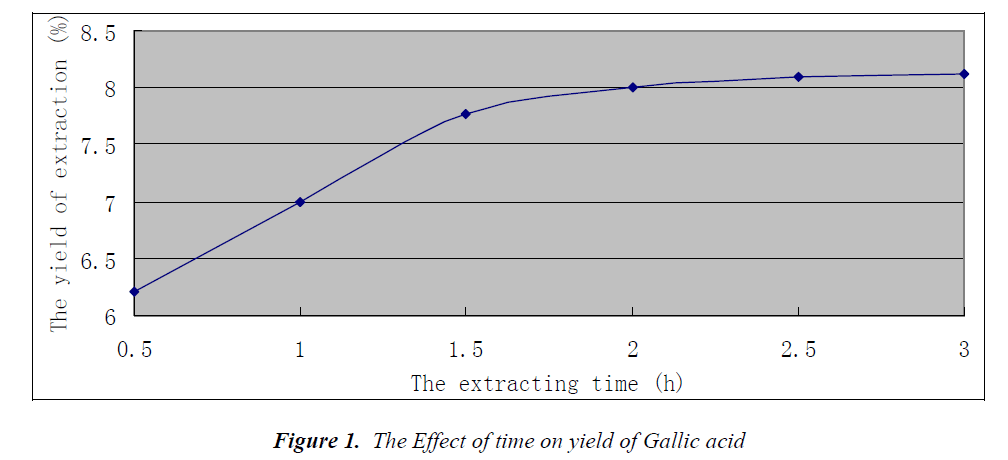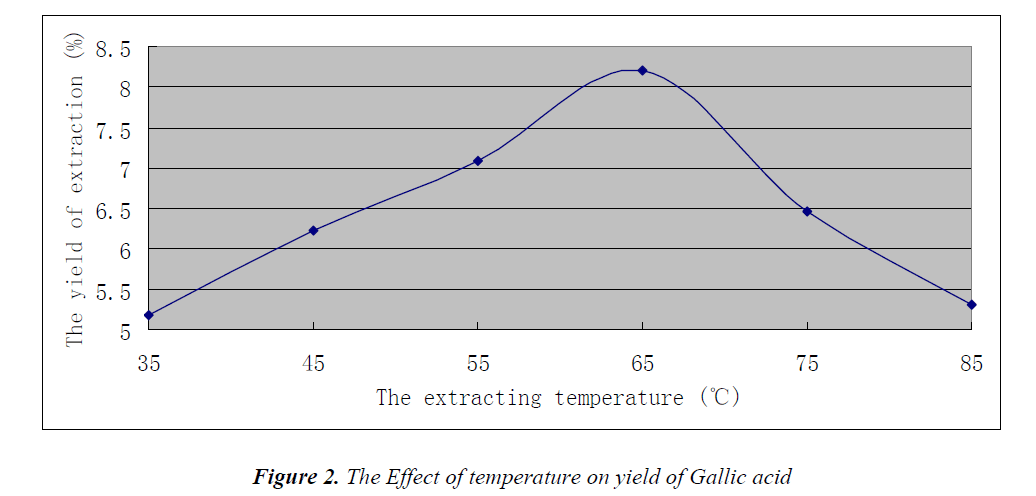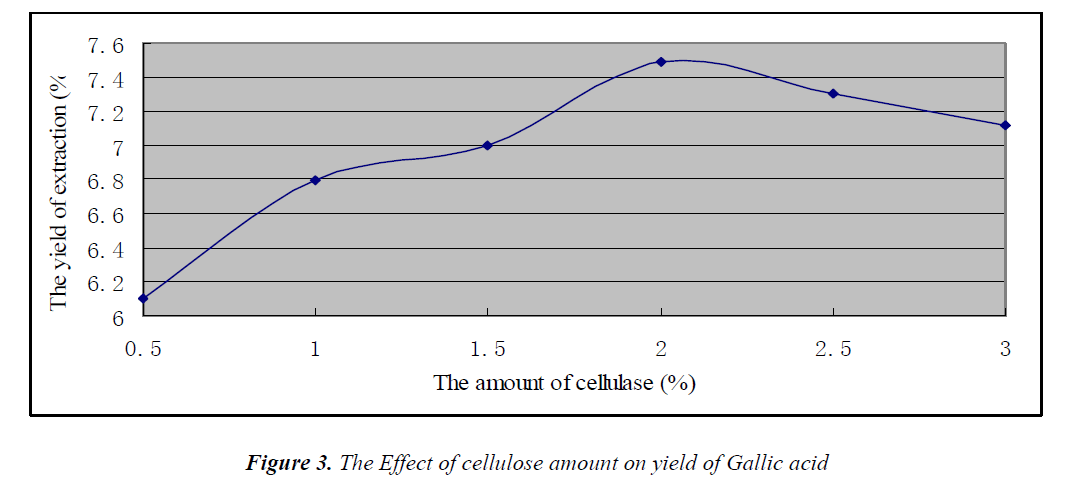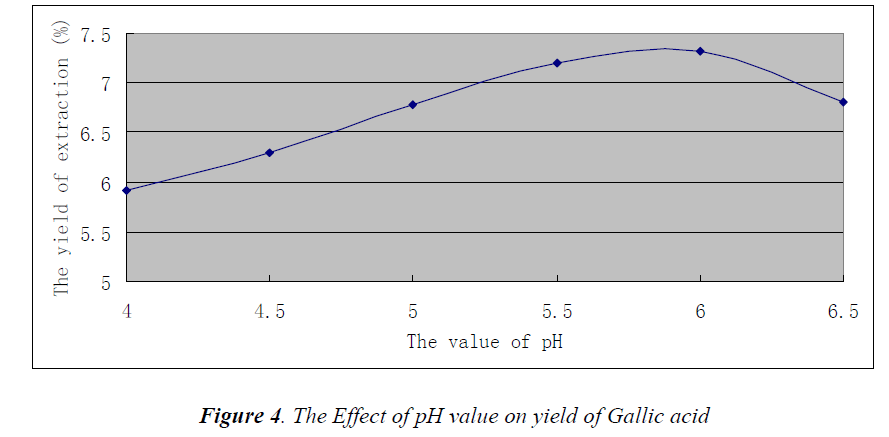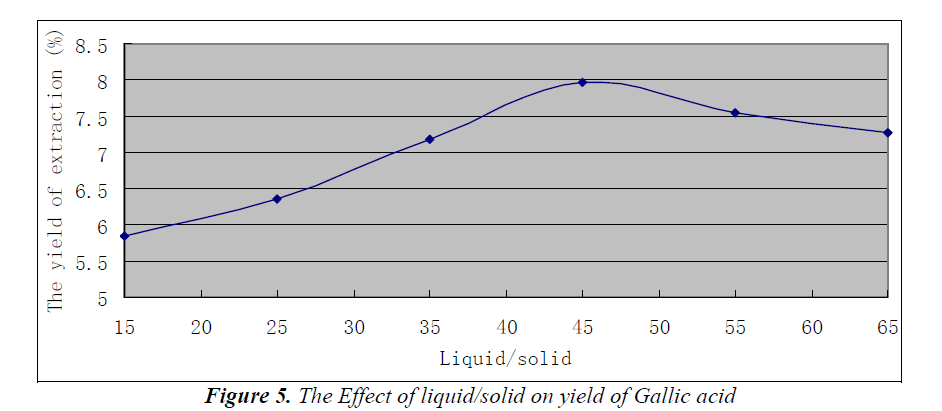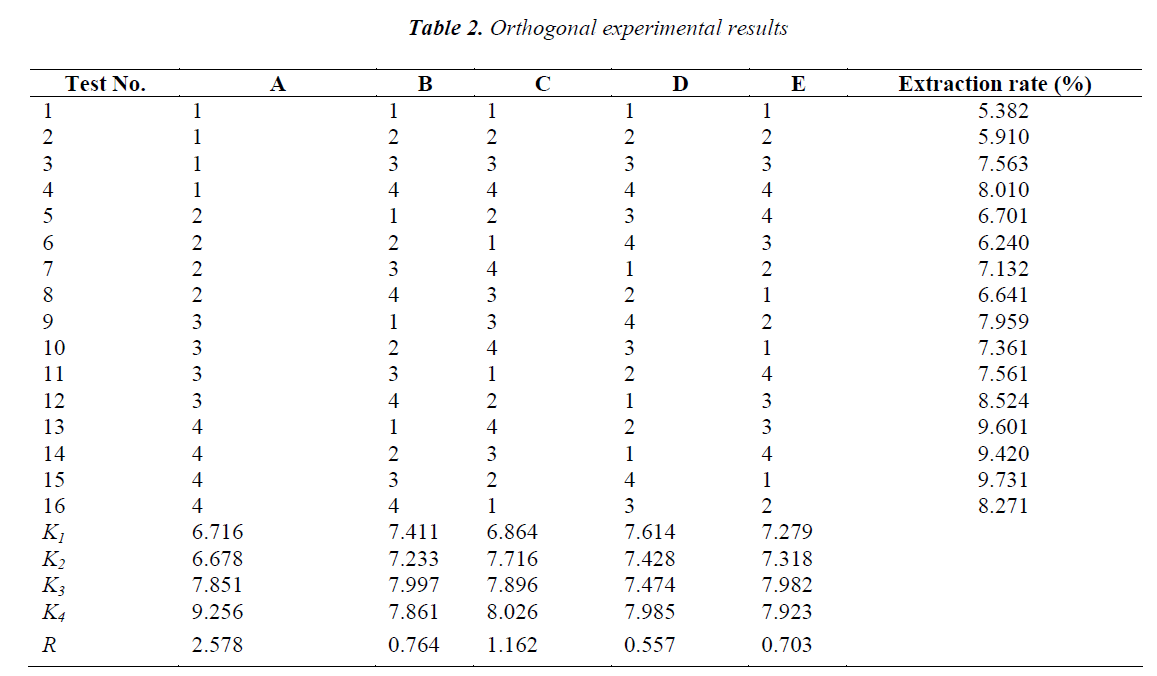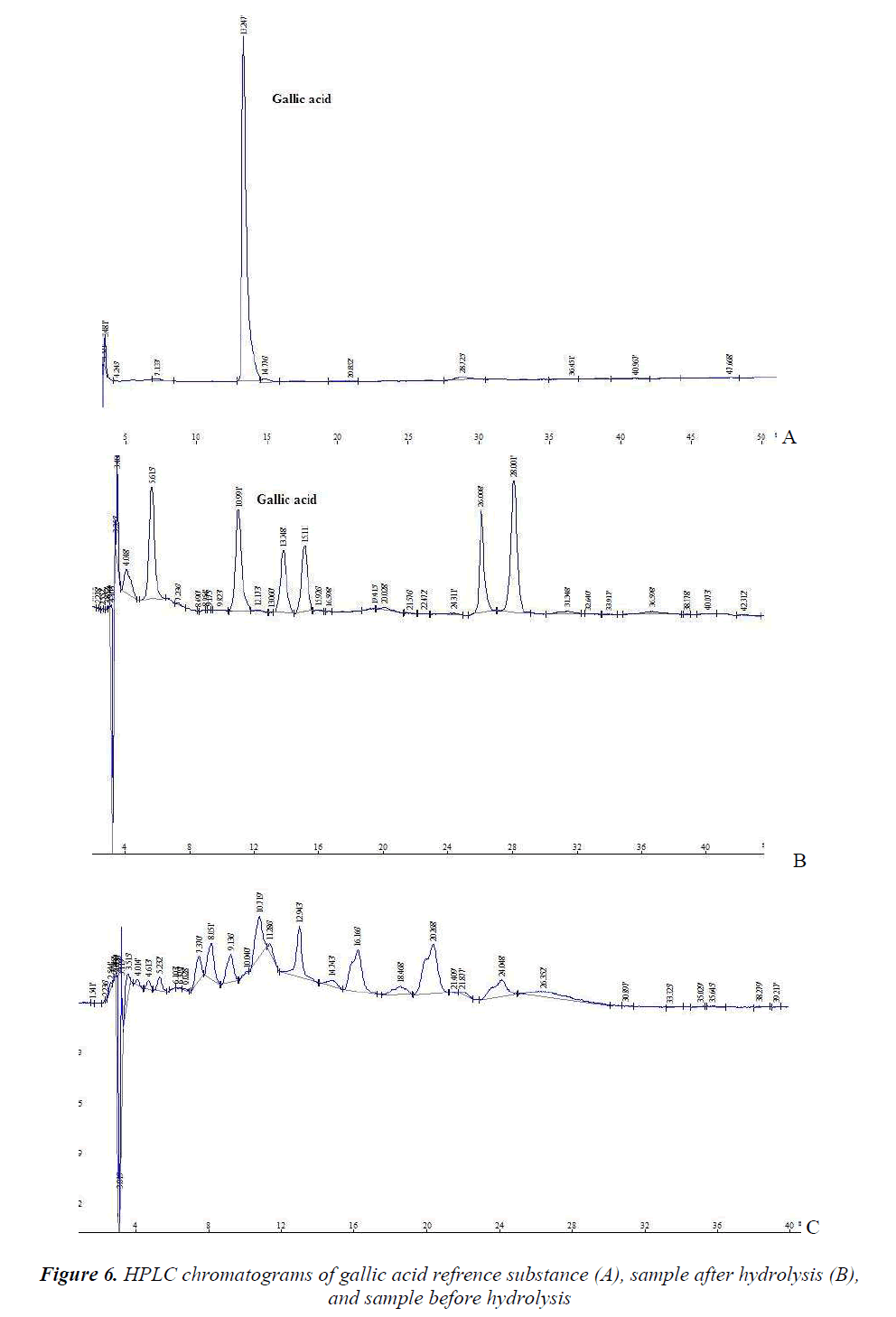ISSN: 0970-938X (Print) | 0976-1683 (Electronic)
Biomedical Research
An International Journal of Medical Sciences
- Biomedical Research (2015) Volume 26, Issue 2
Study on enzymatic extraction of polyphenol constituents in Fructus choerospondiatis.
Emergency Department of The First Afflliated Hospital of Zhejiang Chinese Medicine University, Hangzhou City, Zhejiang Province, 310018 China
- *Corresponding Author:
- Lijie Zhang
Emergency Department
The First Afflliated Hospital of Zhejiang Chinese
Medicine University, Hangzhou City
Zhejiang Province
310018 China
Accepted date: January 15 2015
The objective of the paper is to achieve full utilization of Fructus Choerospondiatis resources, and optimize the extraction process of polyphenols, the active constituents in Fructus Choerospondiatis. Extraction was performed by enzymatic method with total polyphenol content as the investigation indicator, process conditions were optimized using orthogonal design, and the content of gallic acid after enzymatic extraction was determined by HPLC. As results, optimal extraction process of total polyphenols was as follows: extraction time of 2 h, temperature of 65?, enzyme dosage of 1.5%, pH of 6.0, liquid-solid ratio of 45, and total polyphenol extraction rate of 9.923%. In conclusion, the method presented is simple and feasible, which is superior to conventional solvent extraction methods, and thus can be used as the extraction process of total polyphenols in Fructus Choerospondiatis.
Keywords
Fructus Choerospondiatis, Total polyphenols, Enzymatic extraction, Gallic acid, HPLC
Introduction
Fructus Choerospondiatis is the dried ripe fruit of Choerospondias axillaris (Roxb.) Burtt et Hill in the family Anacardiaceae, which is a conventional medicinal material used by the Mongolian nationality, it has antimyocardial ischemic, cardiac function protective and other related actions [1]. There are abundant resources of Fructus Choerospondiatis in China, which are mainly distributed in Guangxi and Guangdong, the herb is a conventional medicine among Mongolian and Tibetan people, constituent analyses of Fructus Choerospondiatis in the literatures have revealed that the herb contains saccharides, amino acids, organic acids, tannins, sterols, flavonoids and phenols [2-5]. Modern studies have shown that total flavonoids have a significant role in the treatment of cardiovascular diseases, and phenolic acids, such as gallic acid, also has significant antioxidant, free radical scavenging and platelet aggregation inhibiting effects and anti-hypoxia activity [6-9].
There have been many reports on the determination of total flavonoids content in Fructus Choerospondiatis, but the HPLC determination of its gallic acid content has been less studied, moreover, the gallic acid content was relatively low. The relatively low content of gallic acid in Fructus Choerospondiatis by HPLC determination is due to lack of optimization of extraction process of phenolic constituents in Fructus Choerospondiatis. In this study, active constituents in Fructus Choerospondiatis was extracted using cellulase, with the aim of exploring a more efficient method for extraction of polyphenols from Fructus Choerospondiatis, meanwhile, a HPLC method for determination of gallic acid content after enzymatic extraction was established, and the quality control criteria for Fructus Choerospondiatis extract, a Tibetan medicine, were developed, providing the basis for industrial production of Fructus Choerospondiatis extract.
Instruments and Materials
Agilent 1200 series DAD HPLC system. Gallic acid reference substance (National Institute for the Control of Pharmaceutical and Biological Products, batch No. 140897-201415, used for content determination); HPLC grade methanol, double distilled water, other reagents were all of analytical grade.
Fructus Choerospondiatis was provided by Beijing Tong Ren Tang Pharmacy, which was identified by Zhang Qingsheng, a researcher of Chengdu Institute of Botany as the dried ripe fruit of Choerospondias axillaris (Roxb.) Burtt et Hill in the family Anacardiaceae; cellulase, with an activity of 750 U/mg, was provided by Guangzhou Kete Biotechnology Co., Ltd.
Methods and Results
HPLC Determination of gallic acid in Fructus Choerospondiatis
Chromatographic conditions
Column: C18 (200 mm × 4.6 mm, 5 μm), mobile phase: methanol-0.2% phosphoric acid (5:95), flow rate: 1.0 mL/min, column temperature: 25℃, detection wavelength: 273 nm, injection volume: 10 μL. Number of theoretical plates was calculated to be not less than 2,000 based on the gallic acid peak. Under such chromatographic conditions, the retention time of gallic acid peak in the chromatogram of sample was consistent with corresponding reference substance.
Preparation of reference solution
Appropriate amount of gallic acid reference substance, which was dried under reduced pressure with phosphorus pentoxide for over 12 h, was accurately weighed, and added with 50% methanol to prepare a 25 μg/mL solution, which was the reference solution.
Preparation of test solution
0.1 g of dried Fructus Choerospondiatis powder was accurately weighed, placed in a stoppered conical flask, added precisely with 50 mL of 50% methanol, weighed, heated under reflux for 60 min, and let cool, then weighed again, followed by recovery of weight loss with 50% methanol. After shaken well, supernatant was filtered through microporous membrane (0.4 5μm), and subsequent filtrate was collected, which was the test solution.
Plotting of standard curve
27.95 mg of gallic acid reference substance was accurately weighed, placed into a 50 mL volumetric flask, dissolved in methanol and diluted to the mark, and shaken well to serve as the stock solution; 1 mL of stock solution was precisely weighed, placed into a 10 mL volumetric flask, diluted to the mark with 50% methanol, and shaken well to serve as the reference solution. 0.5, 5, 10, 15, 20, 25 μL of reference solution, as well as 5 μL of stock solution were aspirated, and injected separately into the liquid chromatograph, chromatograms were recorded, and peak areas were measured. Linear regression was performed with peak area (A) as the ordinate and gallic acid amount (μg) as the abscissa, the regression equation was Y=3852.6X–0.5429, r=0.9998. The results revealed that the injection amount of gallic acid was in a good linearity with the peak area within a range of 0.0280~2.795 μg.
Determination
600 g of dried (40 mesh-sieved) Fructus Choerospondiatis was weighed, and extracted enzymatically as per the conditions listed in orthogonal table. After suction filtration, the filtrate was extracted with nbutanol, evaporated to dryness, and diluted to the mark in a 25 mL volumetric flask with 50% methanol. 5 mL of sample was weighed, and gallic acid content was measured, followed by calculation of extraction rate (extraction rate = mass of dissolved constituents / mass of dry material × 100%).
Single-factor experiments
Influence of time on total polyphenol extraction rate
Extraction was carried out once every half hour under the conditions of liquid-solid ratio of 35: 1 (mass ratio between Fructus Choerospondiatis and water), enzyme dosage of 2% the mass of Fructus Choerospondiatis, pH of 5.0 and extraction temperature of 55℃, the amount of gallic acid in the extract was determined, and relationship curve between time and extraction rate was plotted, the results are shown in Figure 1. As can be seen, amount of gallic acid increased gradually with increasing extraction time, but after 2 h, the amount was substantially constant. So extraction time was selected between 0.5~2 h.
Influence of temperature on gallic acid extraction rate
The influence of temperature on extraction rate was investigated at a liquid-solid ratio of 35: 1, enzyme dosage of 2% the mass of Fructus Choerospondiatis, pH of 5.0 and extraction time of 2 h, and the amount of gallic acid in the extract was determined, the results are shown in Figure 2. As can be seen, when the extraction temperature was between 35~65℃, gallic acid amount gradually increased and reached a maximum, but after 65℃, gallic acid content declined sharply. So extraction temperature was selected between 35~65℃.
Influence of enzyme dosage on total polyphenol extraction rate
The influence of enzyme dosage on extraction rate was investigated at a liquid-solid ratio of 35: 1, pH of 5.0, extraction time of 2 h and extraction temperature of 65℃, and relationship curve between enzyme dosage and extraction rate was plotted, the results are shown in Figure 3. As can be seen, when the enzyme dosage was between 0.5~2%, gallic acid content increased gradually, but after the dosage reached 2%, gallic acid content flattened out. So enzyme dosage was selected between 0.5~2%.
Influence of pH on gallic acid extraction rate
The influence of pH of solution was investigated under the conditions of liquid-solid ratio of 35: 1, enzyme dosage of 2%, extraction time of 2 h and extraction temperature of 65℃, as can be seen from Figure 4, when pH rose from 4.0 to 6.5, total polyphenol content increased gradually and reached a maximum, then decreased. So pH was selected between 4.5~6.0 for extraction of total polyphenol.
Influence of solid-liquid ratio on gallic acid extraction rate
The influence of solid-liquid ratio on extraction rate was investigated under the conditions of liquid-solid ratio of 35: 1, enzyme dosage of 2%, extraction time of 2 h, extraction temperature of 65℃ and pH of 6.0, the results are shown in Figure 5. As can be seen, gallic acid content reached a maximum at a solid-liquid ratio of 45:1. So the appropriate range of solid-liquid ratio was 15~45.
Orthogonal experiment
On the basis of the above single-factor experiments, interaction between various factors was investigated, L16(45) orthogonal experiment was conducted with five factors and four levels, in order to further determine the appropriate extraction conditions. The factors and levels used are shown in Table 1, the experimental results and analysis are shown in Table 2.
Based on the results of range analysis, the degree of influence of factors was determined as: A> C> D> B> E. The best combination was A4B3C4D3E4, which meant that the optimal process conditions were: extraction temperature of 65℃, time of 2 h, pH of 6.0, enzyme dosage of 1.5% and solid-liquid ratio of 45, the results were basically consistent with the single-factor experiments, the optimal extraction rate was 9.923%.
Verification test
According to the results of orthogonal experiment, enzymatic hydrolysis process was tested three repeated times, meanwhile, in the absence of enzyme, three tests were done on extraction process according to the optimized orthogonal experimental conditions, the results are shown in Table 4. As can be seen, the processes both had good reproducibility, but extraction rate increased by 43.0% for the enzyme addition group as compared with the nonenzyme addition group.
Sample determination
Under optimal extraction process conditions, sample was extracted, and test solution was prepared and injected into the HPLC system for determination; the results are shown in Figure 6.
Discussion
Gallic acid is a type of phenolic acid, which is widely distributed in nature, and exists in a variety of families and genera of plants [10-12]. It possesses significant pharmacological activities, such as antioxidant, anticancer and anti-bacterial properties [13-15]. Therefore, gallic acid is in great demand, and used as the main active ingredient in a variety of formulations, for example, Relinqing Granule, Xipayi Mouth Rinse, Zhenzhu Kouchuang Orally Disintegrating Tablets, Qingse Biheimaerjiang Qing Powder and Fuming Capsule which are commonly seen in Chinese market gallic acid all use gallic acid as the main active ingredient. So the exploration of method for efficient extraction of gallic acid is very necessary.
The present experiment explores the method for extraction of active constituents of Fructus Choerospondiatis using HPLC analysis, the experimental results show that the HPLC determination of gallic acid in Fructus Choerospondiatis allows homogeneous solution system, as well as working curve with good linearity. Enzymatic hydrolysis with cellulase can break down β-D-glucose bond in plants more gently, damage cell walls, decompose plant tissues, and accelerate the release of active constituents, thereby improving the extraction yield. The verification test finds that the enzymatic extraction can improve the extraction rate by 43.0%. Enzymatic extraction does not require the use of organic solvents, so it is environmentally friendly, and easy to achieve green industrial production.
In this study, a method for HPLC determination of gallic acid content in Fructus Choerospondiatis extracted with cellulase is established, the method is simple and accurate, which meets the requirements for quality control of gallic acid in Fructus Choerospondiatis extract after cellulase extraction.
References
- Chinese Pharmacopoeia Commission. Pharmacopoeia of the People's Republic of China. Volume I: 2010; 29- 30.
- Lian Z, Zhang C, Li C, Zhou Y. Studies on chemical constituents of Choerospondias axillaris. Zhong Yao Cai 2003; 26: 23-24.
- Yi Y, Yang H, Zhao Y, Bai Z. Extracting flavonoids from Choerospondias axillaris by percolation. Zhong- guo Zhong Yao Za Zhi 2010; 35: 1806-1808.
- Lian Z, Zhang C, Li C, Zhou Y. Studies on chemical constituents of Choerospondias axillaris. Zhong Yao Cai 2003; 26: 23-24.
- Lü YZ, Wang YL, Lou ZX, Zu JY, Liang HQ, Zhou ZL. The isolation and structural determination of narin- genin and choerospondin from the bark of Choero- spondias axillaris. Yao Xue Xue Bao 1983; 18: 199-202.
- Wang H, Gao XD, Zhou GC. In vitro and in vivo anti- oxidant activity of aqueous extract from Choero- spondias axillaris fruit. Food Chemistry 2008; 106: 37-42.
- Li C, He J, Gao Y, Xing Y, Hou J, Tian J. Preventive effect of total flavones of Choerospondias axillaries on ischemia/reperfusion-induced myocardial infarction- related MAPK signaling pathway. Cardiovasc Toxicol 2014; 14: 145-152.
- Li ZX. Effect of the compound of Choerospondias axil- laris on the tolerance to hypoxia and protection from acute myocardial ischemia in animals. Zhong Yao Tong Bao 1985; 10: 42-44.
- Li ZX, Tian FJ, Wu XY, Zhang YP, Tian L, Shi S. Anti-arrhythmic action of total flavones of Choero- spondias axillaris fructus. Zhongguo Yao Li Xue Bao 1984; 5: 251-254.
- Cheng XR, Jin HZ, Qin JJ, Fu JJ, Zhang WD. Chemi- cal constituents of plants from the genus Geum. Chem Biodivers 2011; 8: 203-222.
- Pantelić M, Dabić D, Matijašević S, Davidović S, Do- jčinović B, Milojković-Opsenica D, Tešić Z, Natić M. Chemical characterization of fruit wine made from oblačinska sour cherry. Scientific World Journal 2014; 2014: 454797.
- Esmaeili AH, Hajizadeh Moghaddam A, Chaichi MJ. Identification, determination, and study of antioxidative activities of hesperetin and gallic acid in hydro- alcoholic extract from flowers of Eriobotrya japonica (Lindl.). Avicenna J Phytomed 2014; 4: 260-266.
- Verma S, Singh A, Mishra A. Gallic acid: molecular rival of cancer. Environ Toxicol Pharmacol 2013; 35: 473-485.
- Locatelli C, Filippin-Monteiro FB, Creczynski-Pasa TB. Alkyl esters of gallic acid as anticancer agents: a review. Eur J Med Chem 2013; 60: 233-239.
- Arapitsas P. Hydrolyzable tannin analysis in food. Food Chem 2012; 135: 1708-1717.
